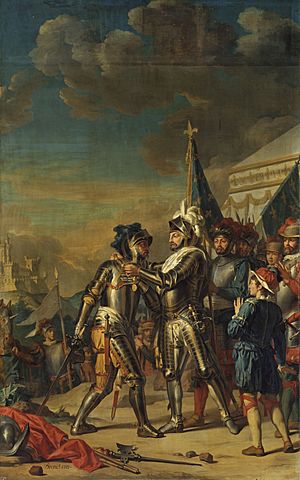Battle of Renty facts for kids
Quick facts for kids Battle of Renty |
|||||||
|---|---|---|---|---|---|---|---|
| Part of the Habsburg-Valois War | |||||||
 King Henry II gives the Order of Saint-Michel to Marshall de Tavannes after the Battle of Renty, on 13 August 1554. |
|||||||
|
|||||||
| Belligerents | |||||||
| Commanders and leaders | |||||||
| Casualties and losses | |||||||
| 2,000 | 240 | ||||||
The Battle of Renty was a big fight that happened on August 13, 1554. It was fought between the armies of France and the Holy Roman Empire. The battle took place near a small village called Renty in northern France. This battle was part of a larger conflict known as the Italian Wars.
Before this battle, a French commander named Francis, Duke of Guise had already made the Emperor Charles V give up his attack on the city of Metz in 1552. The French King, Henry II, had taken control of Metz. This was agreed upon in a deal called the Treaty of Chambord, which he signed with some German princes.
About 30,000 soldiers fought on each side in the Battle of Renty. The French army was led by Francis, Duke of Guise. The Imperial forces were led by Emperor Charles V.
Contents
What Happened at Renty?
The Battle Begins
Renty was a small village that had a strong castle. This castle was held by soldiers from the Spanish part of the Imperial army.
The fighting started on August 13. The French army began firing their cannons at the castle. At first, Emperor Charles V watched from a safe spot and did not join the fight. But then, he decided to send his soldiers into action.
The Emperor's first group of soldiers attacked. The two armies met at the bottom of a hill. The Imperial light cavalry, led by the Duke of Savoy, and some German soldiers called reiters, chased away French soldiers from a forest called Bois Guillaume. This forest was a very important spot on the battlefield.
French Fight Back
The French troops were scattered, but two commanders, Gaspard de Saulx and the Duke of Guise, gathered them again. They then moved forward to attack.
Gaspard II de Coligny, who was an important French admiral, got off his horse. He went into the Bois Guillaume forest with 1,000 of his men. They attacked the Spanish soldiers who were defending the wood. After a tough fight, Coligny's men captured the forest.
This victory in the forest allowed Gaspard de Saulx to charge at the Imperial soldiers. The Duke of Guise also joined the attack, though perhaps a little late.
The French army defeated the Imperial forces. They even captured the Imperial cannons. The Imperial army lost almost 2,000 soldiers in the battle. The French lost about 240 men.
After the Victory
Even though the French won the battle, they had to stop their attack on the castle two days later, on August 15. This was because they ran out of ammunition. The French army went back to Compiègne. But they soon advanced again, forcing Emperor Charles V to retreat.
After the battle, King Henry II gave Gaspard de Saulx a special award, his own Order of Saint-Michel, right there on the battlefield.
What Happened Next?
Treaty and Abdication
After this battle and other events, Emperor Charles V was forced to sign a peace agreement called the Treaty of Vaucelles. Two years later, he gave up his throne and stopped being emperor.
King Henry II of France was able to keep control of three important cities: Metz, Toul, and Verdun. These cities were known as the Three Bishoprics.
French Commanders' Disagreements
The Battle of Renty also showed some problems between the French commanders. After the victory, the Duke of Guise was telling the King and other commanders about the battle. Coligny asked him where he had been during the fight. The Duke of Guise felt insulted by this question. Even though King Henry II tried to make them friends again, Guise never forgave Coligny.
There is a special plaque in the church at Renty that remembers this battle.
See also
 In Spanish: Batalla de Renty para niños
In Spanish: Batalla de Renty para niños

